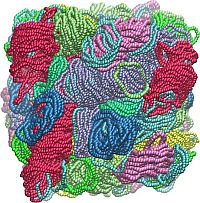The role of ring-polymer topology in macromolecular self-assembly and dynamics
The role of ring-polymer topology in macromolecular self-assembly and dynamics
Research questions:
Ring-shaped macromolecules display a variety of characteristic properties that are diverse from those of their linear counterparts, which stem from their unique topology [1, 2]. Recent progress [3, 4] in the synthesis of ring polymers with various compositions and stiffness opens the way for experimental work of the aforementioned theoretical predictions. The project will focus on investigations of the glassy dynamics and the self-assembly in ring polymers with bending rigidity, covering contour-to persistence length ratios between 5 and 20. The project will provide a reliable coarse-graining strategy that takes faithfully into account the emergence of oblate and prolate-ring subpopulations, the latter playing an important role in the stabilization of the cluster phase. Further, we will investigate the effect of the presence of rigid colloidal additives, such as magnetic filaments or carbon nanotubes in the stability and properties of the cluster phase.

Cluster phase formed by
rigid ring polymers [1].
Methods:
In principle, monomer-resolved simulations can be performed, as in Ref. [1] but this is extremely time-consuming. We will therefore resort to suitably developed coarse-grained models [2], which will be further improved and refined to (a) take into account the shape-change of the rings from oblate to prolate; (b) extended to incude nanorod-nanorod and nanorodring effective interactions; (c) further extended when nanorods are replaced by magnetic filaments. The goal is to reach an understanding of the selfassembly and vitrification of the nanocomposite based on eective potential description.
Time frame:
Months 1-8: derivation and parametrization of the effective potentials between oblate rings and nanorods; months 9-12: same for rings and magnetic filaments; months 12-18: development of a two-state model for the ring polymers to take into account the oblate-prolate transformation of the same; months 18-30: self-assembly of ring-nanorod mixtures; months 31-43: self-assembly of ring-magnetic filament composites; months 44-48 writing of the Ph.D. Thesis and Doctoral Defence.
Participating DCAFM-faculty:
C. Likos (PI), S. Kantorovich (magnetic filaments), P. Ayala (carbon nanotubes), A. Bismarck (polymer nanocomposites), C. Dellago (intercluster hopping rare events).
[1] M. Z. Slimani et al., ACS Macro Letters 3, 611-616 (2014), DOI: 10.1021/mz500117v.
[2] P. Poier et al., Soft Matter 12, 4805-4820 (2016), DOI: 10.1039/C6SM00430J.
[3] G.Polymeropoulosetal., ACS Macro Letters 5, 1242-1246 (2016), DOI:10.1021/acsmacrolett.6b00807. [4] V. Ladelta et al., Macromolecules 51, 2428-2436 (2018), DOI: 10.1021/acs.macromol.8b00153.
